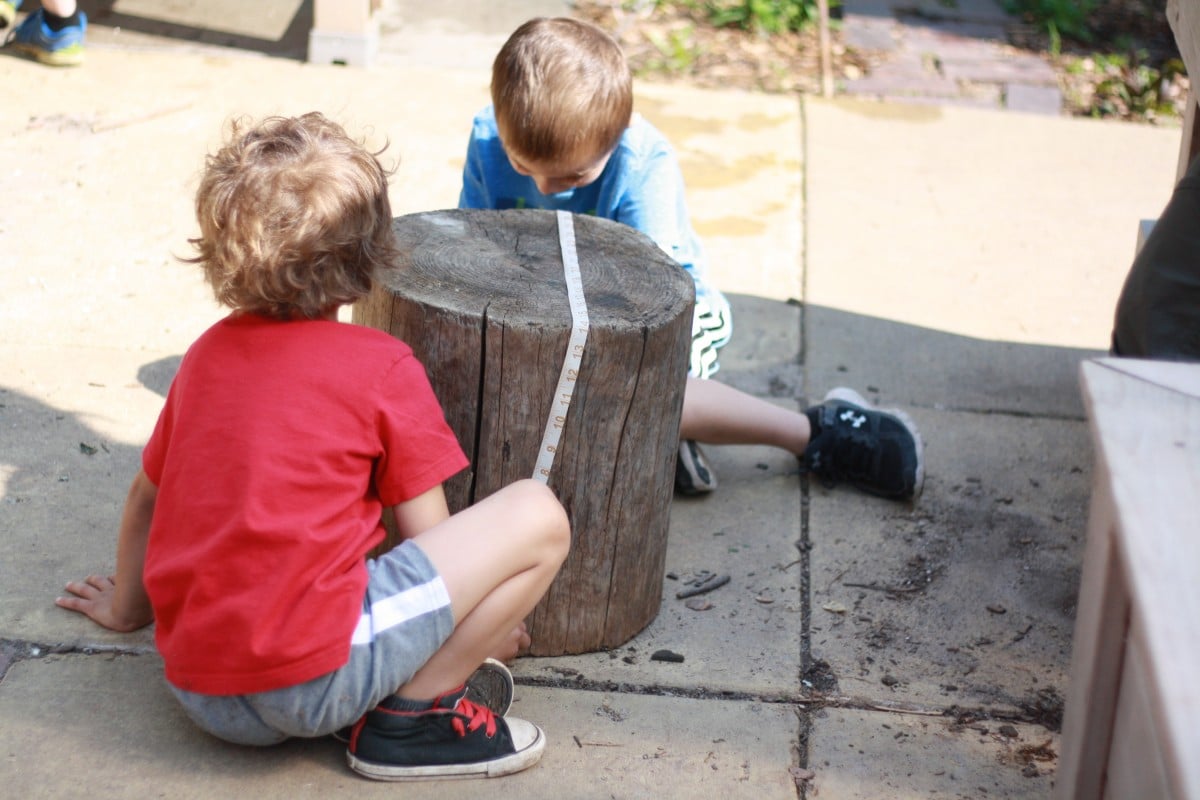Nature + Play = Math Learning

How do we help young children develop early math skills that will provide them with a solid foundation, nurture a continued love of learning, and translate to later success in constructing and applying math knowledge? Many early childhood experts believe the best way to help develop this early foundation is through age-appropriate learning, which for young children means learning through play.
From a Nature Explore Classroom…
Two boys, Nick and Josh (both almost five), were in the Sand Area pretending that they were roasting marshmallows. Mrs V. joined their play. Several bricks formed a circle, and Nick and Josh decided it made a perfect fire ring. As they sat around the “fire,” Mrs. V. asked Nick if he knew how many bricks were in the circle. He touched each brick as he counted aloud and answered, “Ten!” Then the boys decided to make s’mores. After they ate their “s’mores,” which they made using chunks of small tree cookies, Mrs. V. asked Josh to draw a picture of the s’mores for her. He drew them on half of her documentation form, and his drawing included lines and geometric shapes.
Nick and Josh may not have realized it, but in their campfire play, they were developing a number of mathematical skills, including counting, one-to-one correspondence, spatial relationships and geometric shapes. The frequent—and spontaneous—occurrence of play-based math learning is one of the hallmarks of Nature Explore Classrooms.
The outdoor environment is a rich context for mathematical learning. A recent research study highlights the natural materials and experiences available to children in a Certified Nature Explore Classroom that support the development of mathematical concepts. The following anecdote from a teacher-researcher illustrates children experimenting with a number of math skills, including seriation (ordering from smallest to largest), symmetry, math vocabulary, and spatial relationships.
Sketching Flowers – From “Smallest to Biggest”
Preschoolers Lana and Ellie were in the Greenhouse with Mrs. G., talking about what they should draw. Lana decided she was going to draw flowers. She’d had lots of experiences observing flowers in the garden and greenhouse. She began her sketch with the ground and with a seed. She added four flowers of different sizes, from right to left at the bottom of her paper. Each was a different height and as the flowers became larger, so did the leaves. She described her picture to Mrs. G. as “the smallest to the biggest.” She knew the smallest needed to be a seed and then her illustration showed how the seed grew. Her first flower (next to the seed) just had leaves and then they started to get bigger. She illustrated the progression in size as the plant grew. She also added a sun and a cloud at the top of her paper. She said the sun represented “what the flower needed.” Her cloud was “for rain to help the flower grow.”
Following this interaction, Mrs. G. noted the children’s math learning, yet from her students’ perspective, they were immersed in artistic expressions of their own choosing.
Look closely at the activity in a Nature Explore Classroom and you’re likely to observe:
*Children developing key math concepts as they interact with the environment, each other, teachers and materials.
*Children developing rich math vocabulary in the context of their play.
*Natural and living materials unique to Nature Explore Classrooms contributing to children’s math learning.
*Daily opportunities outdoors in nature-filled spaces providing opportunities for children to use their whole bodies to physically experience the math concepts.
This is the fourth in a series of “Roots in Research” blog posts, in which we summarize key findings of research conducted by Nature Explore staff and our colleagues at other institutions.

